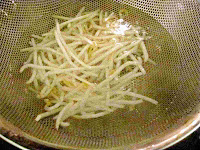<Ingredients>
Handful shungiku garland chrysanthemum (120 g in photo)
Handful moyashi bean sprouts (100 g in photo)
Tiny handful grilled shiozake salted salmon (70g in photo)
Salt (to blanch shungiku; not in photo)
For broth
200 cc dashi
1 tbsp sake + mirin in combination (equal parts)
1 tbsp usukuchi soy sauce
<Directions>
1.
Grill salted salmon, if not already grilled.
2.
Microwave sake + mirin for 10 seconds to get rid of alcohol.
In a container, put dashi, sake + mirin and usukuchi soy sauce, and mix.
Set aside.
3.
Remove skinny root ends, damaged parts and discolored tops of moyashi, wash, and drain.
Remove leaves of shungiku and cut into 4cm.
4.
Bring plenty of water to boil, and first blanch moyashi for 10 seconds.
Remove from hot water and cool. (Here, I blanch moyashi in a strainer for easy and quick removal from boiling water.)
5.
Add a small amount (1/4 tsp or less) of salt to boiling water, and blanch shungiku.
When color brightens, immediately transfer to cold water to stop cooking.
Once cool, squeeze out extra water, and put in broth.
6.
When moyahsi cools to room temperature or cooler, shake off excess water again, and add to broth.
Gently mix.
Roughly break grilled salted salmon and add to broth.
Gently mix, and marinate for at least 20 minutes.
<Notes>
- This is a great way to use a small leftover piece of grilled salted salmon. Alternatively, you can use smoked salmon (hard type, not lox or those in liquid).
- Make sure the broth is cool enough (room temperature or cooler) before adding any goodies.
- Blanching moyashi only for a short time is the key to keeping it crisp. Using firm, very fresh moyashi is also essential. Fresh moyashi is opaque and crispy, and you can break it by bending. In addition to skinny roots and discolored tops, soft sections that look somewhat translucent should be removed before use.
- Adding salt to boiling water tends to make moyashi soggy, thus it is added only for shungiku. Salt is said to brighten the color.
- Above, I used only the leaves of shungiku for a better contrast of textures between soft shungiku leaves and crispy moyashi. However, shungiku stems generally can be added to ohitashi. When using stems, thinly slice them diagonally, and blanch slightly longer than leaves (put stems in boiling water first, then leaves, and remove from boiling water at the same time).















No comments:
Post a Comment